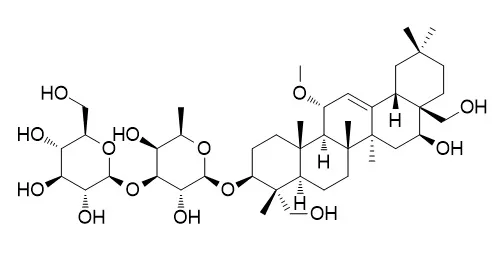| In vitro: |
| Molecules. 2014 Dec 4;19(12):20340-9. | | Saikosaponin D isolated from Bupleurum falcatum inhibits selectin-mediated cell adhesion.[Pubmed: 25486247] |
Three saikosaponins were isolated from the MeOH extract of the roots of Bupleurum falcatum L.: Saikosaponin B3 (1);saikosaponin B4 (2); and saikosaponin D (3).
METHODS AND RESULTS:
Of the three, compound 3 inhibited the interaction of selectins (E, L, and P) and THP-1 cells with IC50 values of 1.8, 3.0 and 4.3 μM, respectively. Also, the aglycone structure 4 of compound 3 showed moderate inhibitory activity on L-selectin-mediated cell adhesion.
CONCLUSIONS:
From these results, we suspect that compound 3 isolated from Bupleurum falcatum roots would be a good candidate for therapeutic strategies to treat inflammation. |
|
| In vivo: |
| Journal of pharmacobio-dynamics, 1980, 3(6):269. | | Analgesic and other pharmacologic actions of saikosaponin in repeated cold stressed (SART stressed) animals[Reference: WebLink] | The pharmacological actions of 7 pure Saikosaponins (a, b1, b2, b3, b4, c and d), the components of Saiko, which plays an important role in Oriental medicine, were studied with special attention to the analgesic effect in repeated cold stressed (SART stressed) mice.
METHODS AND RESULTS:
Single administration of 10 mg/kg of Saikosaponin (SS) in normal mice gave no analgesic effect, but the analgesic effect of b2 and c was great in SART stressed mice, and some analgesic effect was noted with Saikosaponin a, Saikosaponin b1, and Saikosaponin B3 in SART stressed mice. Administration of 5 mg/kg/day of SS for 5 days in SART stressed mice gave an intense analgesic effect with b2 and c, and similar administration of a, b1, b3 and b4 also gave some analgesic effect. The inhibition of the body weight increase in SART stressed mice was counteracted in a dose-dependent manner by administration of 2.5-10 mg/kg/day of SSb2 and c for 5 consecutive days, but similar administration of d augmented the inhibition of body weight. The effect of administration of 5 mg/kg/day of SS for 5 days on the decrease of ACh-response in isolated duodenum from SART stressed mice, which were considered to be in partial vagotonia in small intestine, was studied. While Saikosaponin c, Saikosaponin b1, b2, Saikosaponin B3, Saikosaponin a and Saikosaponin b4 were inhibitory, d was entirely ineffective. The effect of administration of SS on the increase of the ACh-response in isolated duodenum from mice stressed by restraint and water immersion, which were considered to be in partial sympathicotonia in small intestine, was also studied. An inhibitory effect was seen with d, which had been without effect in the specimen from SART stressed mice, while no effect of b2, c and a was noted, despite the positive effect in SART stressed mice. Three kinds of SS effects were distinguished, a central stimulating effect, a central inhibitory effect and a negative effect, based on the hypnotic effect on combined use with pentobarbital, result of measurement of motor activities in open field test in normal mice and experiment on electric resistance of the skin by GSR in SART stressed rats.
CONCLUSIONS:
According to the above results, particularly effects on the change of ACh-response in isolated duodenum, a classification of the action of SS was attempted. |
|






 Cell. 2018 Jan 11;172(1-2):249-261.e12. doi: 10.1016/j.cell.2017.12.019.IF=36.216(2019)
Cell. 2018 Jan 11;172(1-2):249-261.e12. doi: 10.1016/j.cell.2017.12.019.IF=36.216(2019) Cell Metab. 2020 Mar 3;31(3):534-548.e5. doi: 10.1016/j.cmet.2020.01.002.IF=22.415(2019)
Cell Metab. 2020 Mar 3;31(3):534-548.e5. doi: 10.1016/j.cmet.2020.01.002.IF=22.415(2019) Mol Cell. 2017 Nov 16;68(4):673-685.e6. doi: 10.1016/j.molcel.2017.10.022.IF=14.548(2019)
Mol Cell. 2017 Nov 16;68(4):673-685.e6. doi: 10.1016/j.molcel.2017.10.022.IF=14.548(2019)